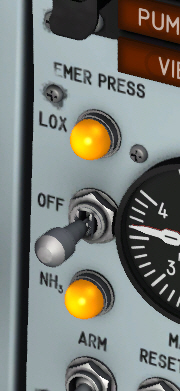The propellant emergency pressurization system can be used to pressurize either the liquid oxygen or the ammonia tank in case of a failure in the normal pressurization system. This will permit continued low thrust engine operation or propellant jettisoning.
The emergency system can supply pressurizing gas to only one propellant tank at a time. The emergency system uses helium from the three interconnected tanks in the engine and propellant control helium system.
The system includes a switch and two caution lights.
Note: Failure of the propellant pressurization system is not simulated in this software version.
This three-position switch [68, fig. 5-1], on the instrument panel, controls primary DC bus power to the two emergency pressurization system solenoid-operated shut-off valves.
With the switch at OFF, the valves are de-energized closed. The switch must be pulled straight out of a détente to move it from OFF to either of the other positions.
With the switch at LOX, electrical power is applied to open the shutoff valve which controls emergency helium pressure to the liquid oxygen tank. With the switch at NH3, electrical power is applied to open the shutoff valve which controls emergency helium pressure to the ammonia tank. All three switch positions are maintained.
Note: Failure of the propellant pressurization system is not simulated in this software version.

Emergency pressurization switch and lights.
These lights [66 and 70, fig. 5-1], on the instrument panel, are powered by the primary DC bus.
The liquid oxygen tank pressure-low caution light is labeled "LOX". The ammonia tank pressure-low caution light is labeled "NH3". The nomenclature for the lights also serves as position nomenclature for the propellant emergency pressurization switch (see above).
After the vent, pressurization, and jettison control lever [11, fig. 5-4] is placed at PRESSURIZE, the related light will come on when pressure in the affected tank drops to 34 (±2) psi.
If a light comes on during powered flight, it may remain on even after emergency pressurization of the affected tank has been initiated, indicating that the affected tank pressure is not above 40 psi.
During the transitional period when the vent, pressurization and jettison lever is moved from VENT to PRESSURIZE, the lights should come on and remain on for approximately 6 seconds (during build-up of pressure in the propellant tanks).
Note: Failure of the propellant pressurization system is not simulated in this software version.